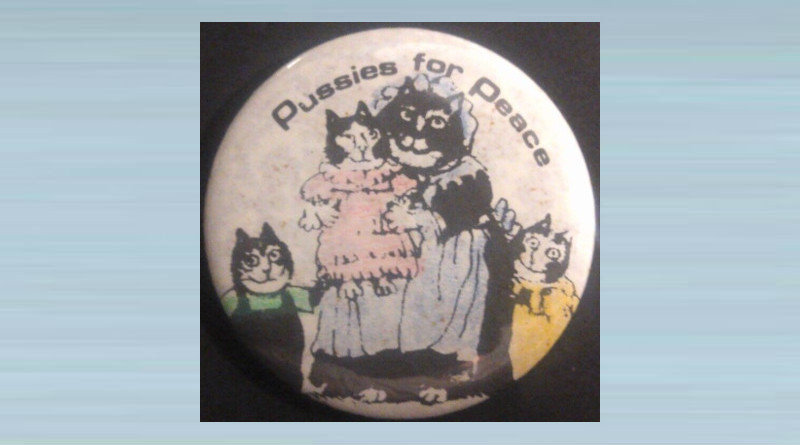


How the peace movement used animal imagery, especially in CND and the Animals Against the Bomb campaign, to create a countercultural protest through badges and playful symbolism.
Throughout the Cold War and beyond, the Campaign for Nuclear Disarmament (CND) was a steady voice calling for an end to nuclear weapons. Among its many forms of protest, one stood out for its gentleness and subversive creativity: the use of animals to convey a powerful anti-war message. This strand of the movement, both heartfelt and whimsical, gave birth to a quietly defiant symbol—animals as icons of peace.
From doves and dogs to rabbits and cats, animals were used to humanise the anti-nuclear cause and broaden its appeal. Rather than evoke fear or anger, these creatures served to provoke empathy, inviting people to consider war not through military might or political rhetoric, but through the innocent eyes of life most vulnerable.
"Animals Against the Bomb" emerged as a semi-organised current within the wider peace movement, particularly active from the 1980s onward. It offered a playful yet poignant form of resistance. With slogans such as “Cats Against the Bomb,” “Bunnies for Peace,” and “Ducks Not Nukes,” these campaigns reframed nuclear disarmament through a non-human lens. The approach was disarming—literally and figuratively—and resonated strongly with children, pacifists, and alternative culture communities.
The message was clear: if animals could protest, what excuse did humans have to remain silent? Behind the charm lay a serious point—that nuclear weapons threaten all life, not just enemy combatants. Animals, unable to participate in politics or war, became pure embodiments of the cost of violence.
Badges were the heartbeat of this cultural offshoot. Often handmade or sold in solidarity stalls at marches and festivals, they served both as protest tools and as personal expressions of conviction. CND embraced this form of messaging wholeheartedly, encouraging creative badge design and distribution.
The badges themselves were playful and varied: a cartoon hedgehog with a placard, a lamb with the CND logo, slogans like “Guinea Pigs Against Genocide.” Some were professionally printed, others sketched in marker and photocopied en masse. Worn on denim jackets, satchels, and jumpers, they became visible acts of solidarity—quiet declarations of hope pinned to everyday life.
Over time, collecting these badges evolved into a small subculture. Young people, activists, and peace supporters exchanged, displayed, and cherished them like protest relics. To some, the badges were simply cute or ironic; to others, they were sacred, emblems of resistance stitched into the fabric of their identity.
This countercultural current stood apart from the mainstream peace movement—less solemn, more inventive, and rich with symbolism. It merged pacifism with humour, appealing to those drawn not just to politics but to alternative ways of living and expressing dissent.
In an era of Cold War paranoia and hard-edged ideology, these soft-spoken animals stood firm. Not with claws or fangs, but with innocence, absurdity, and affection—offering a quiet but fierce rejection of war.
Badges from the “Animals Against the Bomb” era have become cherished items among peace collectors and lovers of alternative culture. Most were made in small quantities by local CND branches, student unions, or independent artists, meaning no two collections are quite alike. Early examples from the 1980s often feature handmade artwork or uneven printing, giving them an unmistakable DIY charm that reflects the grassroots nature of the movement itself.
Designs featuring popular slogans such as “Cats Against the Bomb,” “Bunnies for Peace,” or “Ducks Not Nukes” are the most sought-after, especially those that include local identifiers or original maker marks. Bright colours, hand-drawn animal characters, and visible wear all add to their authenticity and value. Even minor imperfections—scratches, fading, or aged pins—tend to be appreciated rather than dismissed, as they suggest real protest use.
Prices vary depending on rarity and condition: common designs typically sell for £5–£10, while rare or region-specific badges, especially those with original backing cards or event ties, can reach £25 or more. Collectors often display them in thematic groups—by animal, slogan, or location—celebrating them as both art and testimony to a joyful, creative chapter in the history of peace activism.
☮️ Organisation: N/A
🕰️ Age: 1970s onwardss
💎 Rarity: (4-10/10) Less common - Haven't seen another one.
⚙️ Material: Various
📏 Size: Various
🎨 Variations: Various
💰 Price Guide: £20 - £50 is typical
📌 Top Tip: Muffin the Mule is a must-have if it can be found
Badges from the Against The Bomb era have become cherished items among peace collectors and lovers of alternative culture. Most were made in small quantities by local CND branches, student unions, or independent artists, meaning no two collections are quite alike. Early examples from the 1980s often feature handmade artwork or uneven printing, giving them an unmistakable DIY charm that reflects the grassroots nature of the movement itself.
Designs featuring popular slogans such as “Cats Against the Bomb,” “Bunnies for Peace,” or “Ducks Not Nukes” are the most sought-after, especially those that include local identifiers or original maker marks. Bright colours, hand-drawn animal characters, and visible wear all add to their authenticity and value. Even minor imperfections—scratches, fading, or aged pins—tend to be appreciated rather than dismissed, as they suggest real protest use.
Prices vary depending on rarity and condition: common designs typically sell for £5–£10, while rare or region-specific badges, especially those with original backing cards or event ties, can reach £25 or more. Collectors often display them in thematic groups—by animal, slogan, or location—celebrating them as both art and testimony to a joyful, creative chapter in the history of peace activism.